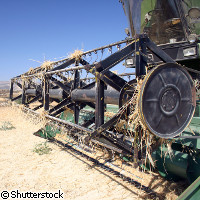Scientists tackle global desertification woes
How significant is the role played by agricultural land use in the reduction of greenhouse gas emissions? Huge, say the world's leading scientists for land management in vast dry areas. Gathering in the Argentine capital of Buenos Aires from 22 to 24 September to discuss climate change and the desertification of dry lands, the experts say that not only is prevention of desertification feasible, but it is imperative for the success of a new climate deal. The Dryland Science for Development (DSD) consortium organised the 'Understanding Desertification and Land Degradation Trends' event, which was held in connection with the Ninth Session of the Conference of the Parties (COP 9) to the United Nations Convention to Combat Desertification (UNCCD). The DSD consists of five research organisations, including the EU's Joint Research Centre's Institute for Environment and Sustainability (JRC-IES), who all have expert knowledge on sustainable land management and land degradation campaigns. Conference members put the spotlight on a crucial issue: in order to fight desertification, standardised, science-based methods must be developed and implemented to help people monitor and assess land degradation. Existing methods have only succeeded in scratching the surface of the problem. Innovative approaches in science and technology can help tackle the causes of desertification and provide answers, they said. Also, a holistic approach can raise awareness and help people overcome the adverse effects of this geologic process, which is triggered by climate conditions and human activity. The more desertification spreads, the greater the loss of the land's productive capacity. Earlier this year, three Working Groups drafted White Papers for the UNCCD conference summarising scientific knowledge for land and water management. According to one of the papers, drylands represent over 40% of the global land area. Just as significant is the fact that around a third of the population resides in these areas. What is alarming is that desertification has already affected as much as 20% of this land. 'We need to view drylands as the front lines in our global effort to help the rural poor cope with climate change,' explained Dr William Dar, Director-General of the International Crops Research Institute for the Semi-Arid Tropics (ICRISAT), a DSD member supported by the Consultative Group on International Agricultural Research (CGIAR). For his part, DSD chairman Mahmoud Solh said, 'The fragile ecosystems of the dry areas are highly vulnerable to land degradation and desertification. Farmers in these areas already face harsh and variable weather and limited resources.' Dr Solh, who is also the Director-General of the International Center for Agriculture Research in the Dry Areas, pointed out that 'we must clearly demonstrate progress in helping them deal with those limitations of today, if they are to have any hope of adapting to climate change tomorrow'. The scientists underline how biodiversity will record a huge loss (an assessment carried out in Rajasthan, India, found that the number of plant species decreased from 54 to 9), and drylands will ultimately fail to provide adequate livelihoods for people. The end result is that social and political instability, as well as rural poverty, will grow. Latest data from the Intergovernmental Panel on Climate Change (IPCC) hint that climate change will continue to wreak havoc on drylands, and expand them by 11% worldwide. According to the experts, degraded drylands fail to conduct carbon sequestration (the removal and storage of carbon from the atmosphere in carbon sinks). Current estimates suggest that soils in dry areas contain over 25% of the global stores of organic carbon. The degradation of these lands causes carbon to be released into the atmosphere. In a nutshell, degraded drylands generate 4% of global emissions every year. 'Science and technology hold the key to coping with the desertification-climate change nexus,' Dr Dar said. 'With the right combination of holistic policies and sustained global action, path-breaking science can help curb desertification and land degradation, improving the livelihoods of millions of poor people in drylands.'



